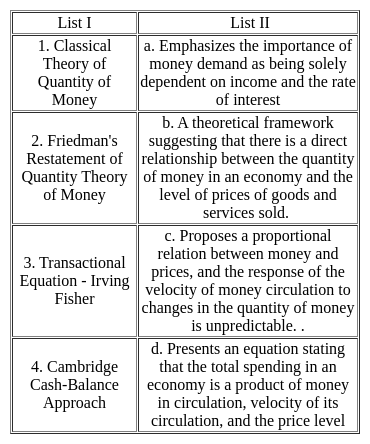UGC NET Paper 2 Economics Mock Test - 1 - UGC NET MCQ
30 Questions MCQ Test UGC NET Mock Test Series 2024 - UGC NET Paper 2 Economics Mock Test - 1
Based on which index, the study finds convergence with HDI in the passage ?
Which two data points has been used to find convergence in HDI ?
| 1 Crore+ students have signed up on EduRev. Have you? Download the App |
Consider the following statements about the World Trade Organisation (WTO):
1. The Uruguay Round culminated in the Marrakesh Agreement, which established the World Trade Organization (WTO).
2. WTO is a UN specialized agency.
3. The topmost decision-making body of the WTO is the Ministerial Conference, which usually meets annually.
Which of the above statement(s) is/are correct?
With reference to the Indian economy, consider the following statements:
1. A treasury bill is a promissory note issued by the Reserve Bank of India to meet the long-term requirement of funds.
2. Call money is mainly used by the banks to meet their temporary requirement of cash.
3. Commercial paper is an unsecured, short period debt tool issued by a company, usually for the finance and inventories and temporary liabilities.
Which of the statements given above is/are correct?
The first bi-monthly monetary policy statement for fiscal year 2015-16 was released in which month?
How many MoUs have been signed between India and United States on 25th Jan 15 as part of Indian Government ambitious “Smart Cities” Scheme?
The table below consists of two lists of events/theories/models/statements and the other of authors. Match an item in one list with an item in the other and mark the correct option using the codes given below.

Assertion A): U-shaped long-run average cost curve is based on the assumption that economies of scale prevails at small levels of production and diseconomies of scale prevails at larger level of production.
Reason R): Decreasing returns to scale arises primarily because as the scale of operation increases, it becomes even more difficult to manage the firm effectively.
In the context of the above two statements, which one of the following codes is correct?
With reference to the Indian economy, consider the following statements :
1. The Gross Domestic Product (GDP) has increased by four times in the last 10 years.
2. The percentage share of the Public Sector in GDP has declined in the last 10 years.
Which of the statements, given above is/are correct?What do you understand by Kuznet Inverted U Cruve?
1. It is a curve representing that income Inequality rises in the initial stages of development, stabilizes for a time and then declines later.
2. It is a curve representing that the rise in income Inequality slow in the initial stages of development, but over time the inequality between the rich and the poor keeps on increasing.
Select the correct answer using the code given below:-Goods for which demand move in the opposite direction of the income of the consumer are called?
Which of the following are included in the assets of the Reserve Bank of India?
1. Treasury bills
2. Paid-up Capital and Reserve Fund
3. Ways and means advances
4. Currency Notes in circulation
Select the correct answer using the code given below.
Due to distress in agriculture sector, the government can face which of the following demands from the farmers?
According to the passage, what are the main reasons for the damage of the crops in India?
A. Unseasonal Rains
B. Lack of Financial Support
C. Lack of Irrigation Facility
D. Hot Climate
The growth rate in agricultures sector compared to other sector:
According to the passage, the growth in the India’s GDP is:
|
16 docs|120 tests
|



















